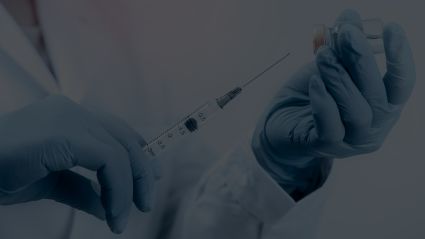Submitted electronically
| The Honorable Anna Eshoo Committee on Energy and Commerce US House of Representatives Washington, DC 20515 | The Honorable Richard Hudson Committee on Energy and Commerce US House of Representatives Washington, DC 20515 |
Dear Representative Eshoo and Representative Hudson,
Thank you for the opportunity to provide comments in preparation for the Pandemic and All-Hazards Preparedness Act (PAHPA) reauthorization. We commend the Energy and Commerce Committee’s bipartisan leadership for providing this opportunity to stakeholders to add our perspective ahead of the reauthorization. We look forward to collaborating with the Committee on policies that will improve and strengthen the nation’s biosecurity and preparedness infrastructure.
FasterCures and the Center for Public Health are centers of the Milken Institute, a nonprofit, nonpartisan think tank focused on accelerating measurable progress on the path to a meaningful life. As part of the Milken Institute, FasterCures and the Center for Public Health work to catalyze practical, scalable solutions to address the challenges of our biomedical and public health systems, respectively. Guided by a conviction that the best ideas, under-resourced, cannot succeed, we conduct research and analysis and convene top experts, innovators, and influencers from different backgrounds and competing viewpoints. We leverage this expertise and insight to construct programs and policy initiatives.
In this letter, we offer our comments in response to the request for information. These comments are informed by our research and input we have collected through the course of multiple convenings we have held about related topics.
National Health Security Strategy (NHSS)
The NHSS outlines a vision to strengthen our nation’s ability to prevent, detect, prepare for, and respond to 21st-century health threats. In the reauthorization of PAHPA, we recommend the NHSS continue to emphasize a whole-of-society approach and to consider the following:
- Establish early warning capabilities as a core component of efforts to improve situational awareness and to protect the nation from emerging and pandemic infectious diseases. In the future, many new pathogens are expected to be zoonotic in origin due to land-use changes, food-production practices, and population growth—both at home and abroad. As zoonotic outbreaks become more frequent, biosurveillance systems will need to monitor the effects of these changes on animal health and their potential spillover to humans. In this area, aligning with partners globally will be critical. Relatedly, the NHSS acknowledges the importance of promoting a One Health approach to early warning detection and diagnosis. However, actions to carry out such an approach were absent from the accompanying implementation plan for the 2019–2022 strategy. In the reauthorization, we recommend greater prominence be given to how a One Health approach can be implemented.
- Advance a framework for private-sector engagement in preparing for and responding to emergencies. The NHSS recognizes the private sector’s critical role in confronting new vulnerabilities, particularly in the development and availability of medical countermeasures. However, to avoid transactional relationships with the private sector, we urge the NHSS to articulate a framework for private-sector engagement with the US government at the time of strategy or program formulation. To the extent feasible, the US government should look to co-construct preparedness and response strategies alongside representatives of the private sector so that the capabilities and resources of the private sector can be built into scenario planning and tabletop exercises. We also encourage a broader view of the private sector beyond the health and medical product sector to include organizations in data, technology, agriculture, and finance, which can bring to bear nontraditional data systems, advanced analytics, and cutting-edge technologies.
The comments above are further detailed in a letter that we submitted to ASPR to inform the 2023-2026 NHSS on March 11, 2022.
Hospital Preparedness Program
At the onset of the COVID-19 pandemic, the United States quickly realized the government struggled to collect real-time, accurate, and integrated data on infections, hospitalizations, deaths, and more. There was no standardization in data infrastructure, with existing systems lacking interoperability and functioning in fragmented silos. Beginning in April 2020, the Federal Emergency Management Agency (FEMA) at the National Response Coordination Center, the US Department of Health and Human Services (HHS), and private-sector distributors were in coordination with jurisdictional partners and hospitals to create the Supply Chain Control Tower (SCCT), a new public-private partnership that began in an informatics storage and processing application. It grew throughout the pandemic to include pharmaceutical distribution, COVID-19 testing equipment, and hospital inventory.
Initially, FEMA, HHS, and the private-sector partners operated under these parallel, unconnected systems, which led to operational challenges. As the pandemic response evolved, health-care distributors opted into data sharing in the SCCT, recognizing they had essential information to share to ensure communities were supported. The Control Tower multisector collaboration identified inventory movement and supply chain through the centralization and modernization of data, including allocation predictions using public-health data.
Existing and long-standing relations between distributors and the government were instrumental in integrating data across sectors. Currently, the SCCT has eight distributors who voluntarily provide limited data about the supply of five PPE categories, 30+ pharmaceuticals, and other medical products on a near-daily basis. The SCCT has also integrated supply status from around 5,000 hospitals and 15,800 long-term care facilities.
The reauthorization of PAHPA presents an opportunity to standardize health data reporting in the SCCT program. We suggest including language to provide distributors with data analytic parameters to ensure information is recorded and reported using consistent standards and flows bidirectionally across the supply chain. Applied extensions of the SCCT model that leverage existing data platforms to drive decision-making in response to public health crises other than COVID-19 should be examined and prioritized.
National Disaster Medical System (NDMS)
The COVID-19 pandemic elucidated the reality that not all communities have equitable access to the health-care resources and services necessary to respond effectively to a public health emergency. While national and regional efforts to address health-care preparedness challenges, establish best practices, and increase medical surge capacity are much needed, they are futile without considering and involving health-care access points (e.g., pharmacies, Federally Qualified Health Centers, and clinics) serving rural and/or under-resourced communities.
To ensure that communities are represented in future efforts to stand up a more comprehensive public health emergency system capable of responding to health security threats, we suggest the reauthorization of Title III of PAHPA and call for a study from the Government Accountability Office (GAO) that reflects data and information sharing abilities from pharmacies, Federally Qualified Health Centers, clinics, et cetera, and the public sector during the COVID-19 pandemic. Appropriate measures include sharing data and information related to medical surge capacity, workforce availability and capacity, personal protective equipment, and vaccine distribution.
Strategic National Stockpile
Public health responses to the COVID-19 pandemic demonstrated the strength of public-private partnerships (PPPs) in bolstering the resiliency of the pharmaceutical supply chain in support of public health nationally, regionally, and locally. Our research identified that well-designed PPPs—linking the public and private sectors—fostered a more comprehensive “last-inch delivery” of medications to enable increased access to health-care products and services to communities, especially those that have been historically marginalized and under-resourced. The federal government should consult successful PPPs enacted before and during the COVID-19 pandemic to evaluate those most useful to continue and how future partnerships may be best used. Examples include the Public Health Emergency Medical Countermeasures Enterprise, the Supply Chain Control Tower, Operation Warp Speed, and the Strategic National Stockpile (SNS).
In the reauthorization of PAHPA, we encourage enacting policies that sustain long-term opportunities and commitments for PPPs specific to the SNS to enhance coordination of the production, distribution, and delivery of critical medicine and supplies. Biomedical manufacturers and health supply-chain distributors have crucial expertise and resources that should be leveraged during emergencies, while supporting public health goals broadly. These stakeholders must be regarded as essential partners and therefore be included in planning considerations for appropriate distribution capabilities, capacity, and utilization for the SNS to understand what is readily available in the market.
To further equip the SNS, we recommend the inclusion of HR 405, the Essential Medicines Strategic Stockpile Act, as part of the PAHPA reauthorization to require that HHS establish a list of 50 generic drugs that are essential to a public health emergency and subsequent response. To go a step further, Congress may want to create a mechanism that enables enhanced visibility and early notification of potential drug shortages, particularly around essential medicines.
Additionally, we encourage the consideration of public- and private-sector collaboration to develop shared metrics that reward partner quality, reliability, and sustained engagement. Despite the demonstrated strengths of PPPs in response to the COVID-19 pandemic, partnership strains were observed among stakeholders who were less willing to leverage their regular business model to form unique partnerships supporting the production of much-needed supplies, resulting in offered solutions that were less likely to succeed. Therefore, recording partnerships in a comprehensive registry of private-sector supply chain health partners that profiles their expertise, capacity to engage, geographic reach, and other core competencies will streamline efficiency to bolster preparedness and response.
Additional Provisions
We urge you to enact the Pioneering Antimicrobial Subscriptions to End Upsurging Resistance (PASTEUR) Act in the reauthorization of PAHPA. The PASTEUR Act creates a new mechanism for paying for antibiotics that would help revitalize the antibiotic development pipeline and bolster our nation’s ability to prepare for and respond to threats that include pandemics, natural disasters, and other biological threats.
Antimicrobial resistance (AMR) is a significant public health threat often described as a silent pandemic. Many experts believe antibiotic-resistant infections threaten our society more than the COVID-19 pandemic. Over 3 million people in the United States suffer from antibiotic-resistant infections every year, resulting in at least 50,000 deaths. Globally, AMR is a leading cause of death that has been connected to nearly 5 million deaths in 2019. Without any concerted action, it is estimated that the global death toll from AMR could reach as high as 10 million by 2050. The COVID-19 pandemic has only worsened AMR, with rates of drug-resistant hospital-onset infections and deaths jumping at least 15 percent in the first year of the pandemic alone.
Despite the substantial need, antibiotics development has received little investment. The development of antibiotics, like all medicines, takes years and significant resources. Yet, when new antibiotics reach the market, they face a far more uncertain market than other medicines due to low prescription volumes and prices. This combination makes it difficult for an antibiotics developer to sustain the manufacturing and operational costs necessary to keep the drug on the market. Our research has found that the PASTEUR Act, which outlines a new payment mechanism for antibiotics that delinks payment from volumes, would open the door to new, much-needed investment in this sector because it provides developers with the possibility of a predictable revenue stream. In addition, it should be noted that most R&D in antibiotics today is conducted by small, single-product companies, not large pharmaceutical companies. With every month and year that passes when we do not solve the AMR crisis, these small companies will shutter their doors, and expertise will continue to dwindle as scientists and researchers leave the field.
Priorities
The request for information asks stakeholders to provide the top three priorities in order of preference. Recognizing that the reauthorization of PAHPA provides numerous opportunities to strengthen the nation’s response in the face of a future pandemic and other hazards, we offer the priorities below:
- The enactment of the PASTEUR Act in the reauthorization of PAHPA to address the financial challenges affecting antibiotic development.
- Establishing and investing in robust early warning capabilities as a core component of biosurveillance activities.
- Long-term commitments for public-private partnerships (such as the Strategic National Stockpile and Supply Chain Control Tower) with enhanced coordination to support pharmaceutical supply chain resilience.
Thank you for the opportunity to provide comments on the request for information regarding the Pandemic and All-Hazards Preparedness Act reauthorization. The Milken Institute welcomes the opportunity to provide additional detail on the information above and serve as a resource as you continue to refine the legislation.
Sincerely,
Esther Krofah
Executive Vice President of Health
Milken Institute











